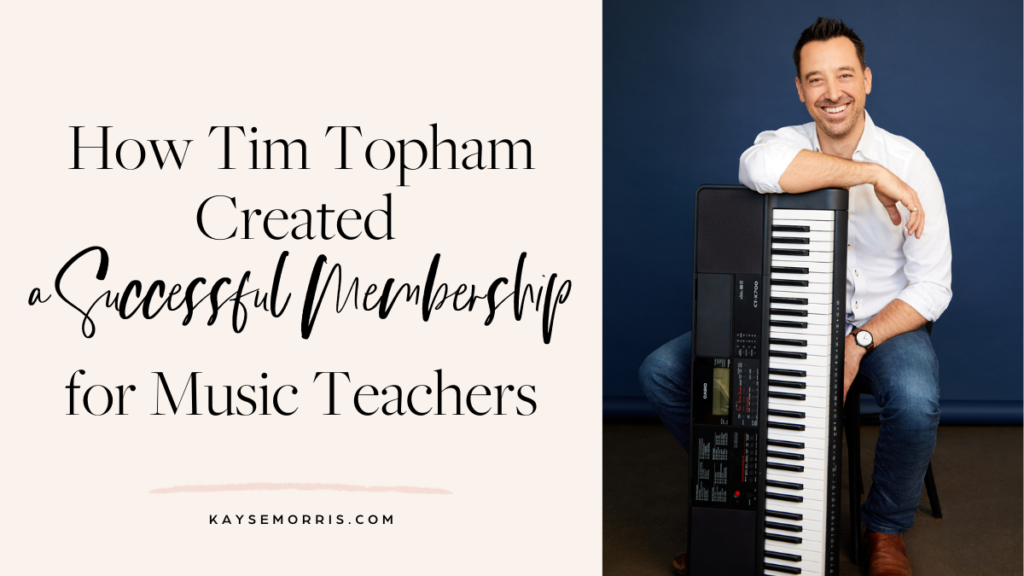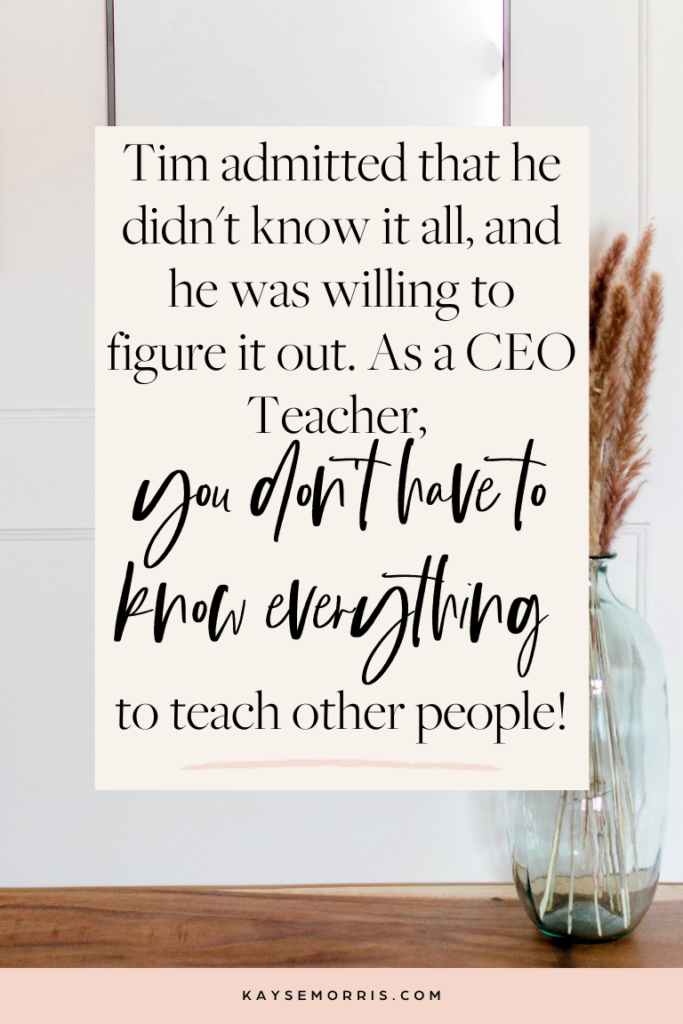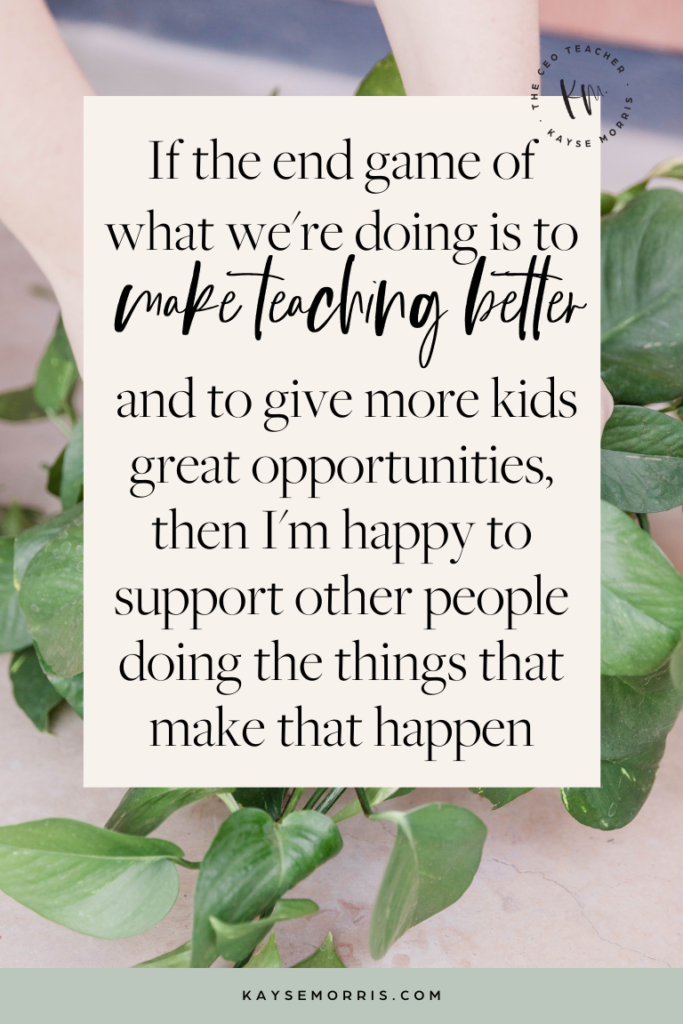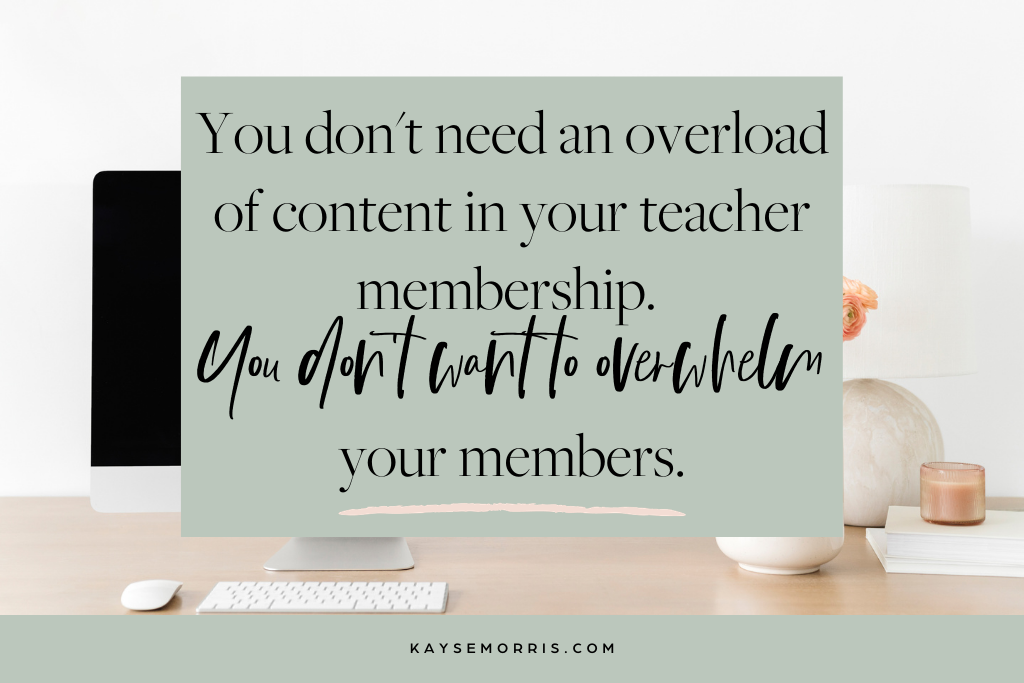How Tim Topham Created a Successful Membership for Music Teachers
I had the chance to sit down and interview Tim Topham from Top Music, and he shared some of his best tips and strategies he’s used to grow his very successful business where he serves music teachers. He has branched out into creating courses and teacher memberships, and he has a podcast for music teachers as well. His journey as a music teacher and entrepreneur is so incredible, and I’m thrilled to share it with you. If you want to pop your earbuds in and listen to this interview as well, click here for our chat on The CEO Teacher Podcast!

Tim Topham’s Journey to Become a Music Teacher & Entrepreneur
Tim has been a teacher for about 22 years. He majored in music at school and afterward studied music in university. But, he soon realized his passion was in education! He was able to take kids camping, sailing, and rock climbing at 18 years old, and little did he know that would fuel his passion to learn how to become a music teacher.
Tim taught in England and other places in Australia. And then he got pulled into music, in particular, teaching piano. Now, looking back, it’s what he’s built my business around- the independent music teacher.
He got back into music to earn some money. He even thought he wanted to be a music producer! He tried being a remixing music producer. I wanted to create music that people would dance along to in nightclubs. His goal was for his music to be played on the radio and make millions of dollars, but it didn’t happen. However, while he was doing that, he picked up some piano students, even though he hadn’t taught piano before and didn’t really know what he was doing.
So he found his retired childhood piano teacher and asked for her help. It became a real mentorship for a whole summer, and they got together every day so he could learn from her, which inspired him to become a music teacher again!
The teaching he does now as a music teacher is an innovative look at music from a broad perspective so that kids can try all sorts of things in music. All of his past experiences in and out of music led him to where he is today.
Lessons Learned from this Music Teacher’s Story
Tim was teaching students music and realized he didn’t know everything, so he found a music teacher to help him. He admitted that he didn’t know it all, and he was willing to figure it all out, which gave him renewed excitement to teach music. As a CEO Teacher, you don’t have to know everything to teach other people! Tim has proven that it is so much more important to jump in than to try to learn everything first. The more you learn on the go through experience, the better the experience can become to you, and you can pass your learning onto others!
When he was working with his music teacher, he learned as much as he could. He took courses, went to masterclasses, watched lectures and recitals, and practiced by challenging himself. It was a complete immersion! Something you can take from Tim’s journey is that going all-in is always worth it because you learn so much in the process!

How Tim Started Helping Music Teachers Online
When he started blogging and recording videos for his YouTube channel, he realized that other music teachers had the same desire to branch out from the classical teaching approach to give their students a wide range of musical experiences. That’s what led him to create his first course for music teachers.
Remember, CEO Teacher, this doesn’t just happen overnight. Tim studied music, left music, and returned to it to learn how to teach it. Then, he started sharing his passion for teaching music online with other teachers. This journey isn’t something we map out ahead of time and have all figured out. You have to fall on your face and stumble first and try different roads before finding your road to success and happiness.
Tim never really intended for this online music teacher success to happen, but he started blogging in 2010. And, by the end of 2014, he released his first course. Everyone’s journey looks different time-wise, but it takes time to find some people who like what you do and get feedback from them. When he did get feedback from other music teachers, they wanted to know how to teach their students Pop music, but they didn’t know how to play by ear or teach them that kind of music.
“People want that in which they help create.” I love that quote, and it rings true here. Tim listened to his people and created a course for them. He made his first sale on New Year’s Eve in 2014, and he just kept creating music teachers’ resources from there!

Tim Learned How to Give Music Teachers Resources and the Support They Needed
After Tim created his course, he found that music teachers wanted more and kept asking for help. He kept getting questions, but no one else could see those questions directly. He wanted to get the community of music teachers together somehow, which was part of how he created his membership.
It took time for his business to grow and evolve and to become successful. Remember, Tim started his music teacher website in 2010, and he just celebrated the fifth anniversary of his membership, which means he started it five years after his business started. Good things take time, and they are worth the hard work.
Tim serves his people well. They engaged with his blog, and so he served them more with YouTube videos. That started to take off, and he developed his podcast. Everything was an organic process and linked together in a chain of events. Don’t try to bite off more than you can chew at one time. You’ve got to keep your eyes focused on your main thing and serving your people, and your business will grow! Start with what you’re comfortable with, and go from there.
Nuggets of Wisdom from Tim’s Growth of Helping Music Teachers Online
Give value first, through your blog, podcast, or YouTube channel. Work on the hard stuff like search engine optimization and creating content even when you don’t feel like it. Consistency and persistence win every time.
Tim started his podcast in 2015, and there weren’t other podcasts like his yet. He was learning and growing and sharing before the awareness was there. But now that there is competition in the online music teacher space, he welcomes it. He knows there is room for everyone because we all have our unique perspectives.
He believes that a rising tide lifts all boats. If the end game of what we're doing is to make teaching better and to give more kids in the world great opportunities through the education that they're getting, then he’s happy to support other people doing the things that make that happen.

You Can Support Teachers in a Variety of Ways Online as Tim Has Done With His Course and Membership for Teachers
Tim started by creating a course, and once he was serving music teachers and realized they needed more of a community, he started thinking about creating a membership. This was in 2015, and there weren’t platforms to host your membership on yet, so he built his own website on WordPress. It took time, and he did it all himself. He started building the membership in September of 2015 and launched in March of 2016.
He started his music teacher membership with a beta launch with a few of his core followers. It took a few months for members to start trickling in and building that sense of community. It’s challenging and hard not to doubt yourself. He found that once he added more courses and learned more about what his music teacher community wanted to do, everything made sense with the membership. Remember, action brings clarity, and clarity produces results.
What a Growing Music Teacher Membership Looks Like
People paid a monthly or annual fee to join the membership, and Tim tried to keep it simple. The music teachers would get access to the forums to ask him and the community questions. He also invited some expert teachers into the membership who were well-known in their industry. The members in his membership would get his main course, the music teacher lesson plans, and he would add a new course each month.
He was also still teaching full-time and teaching private students after school at that time. Tim mentioned that it was challenging, but he also had so many ideas to get out there, that he was in content creation mode. He thought he needed so much stuff inside his membership and created a new course each month to retain members.
Learn from this: you don’t need an overload of content in your teacher membership. You do need some new stuff every month, but make sure you don’t overwhelm your members. It's not about the stuff; it's about what value they can get and the outcome that you can give them.

We recommend doing regular surveys to ask your members to give their thoughts on the content you’re creating. Getting feedback will help you know if you’re on track and supporting your members well.
Launching a Membership with Music Teachers Resources
Tim doesn’t do an open and closed cart model as I do. His membership is always open, and he runs promotions and webinars to promote it. Now, he’s trying five-day challenges this year. They’re shorter and give teachers an action plan. He said that they will use that approach to find new people to bring into his online community.
He has a specific number of members he wants to enroll for each webinar he does, and now he’s diversifying into multiple tiers of his membership. This means that it allows music teachers to move up and down inside his ecosystem. If they need a break, they can drop down a level. And if they like what the content is for that period, they can upgrade. This changes how he thinks about the numbers and goals for getting new members into the program.
How to Get Started Creating a Membership for Teachers
Make sure your audience wants what you are going to offer before you run down this road. Running a membership is challenging. It will test you, and you'll need to make sure that you're able to serve the people that are following you. Remember that you don’t need thousands of hours of stuff in your membership before you open it. If you have a core audience who are already following you, find out what they want in a membership!
If you can find out how much people are willing to spend on the membership and what they are looking for before you build the thing, you won’t build something people don’t want. Start with the Minimum Viable Product – something that serves a purpose and keeps your program simple. It’s an excellent approach to think, “You know, how can I use what I have? How could I turn that blog article into a great video for my members?”

If you would like to connect with Tim and learn more about his membership for music teachers, click on these links:
Tim Topham is a wealth of knowledge and a true CEO Teacher. His hard work, determination, flexibility, and service-focused attitude have helped him create a successful business to help music teachers online through his membership and more. If you need help taking your business to the next level, or if you’re just beginning your CEO teacher journey, click here for your guide to start or expand your online teacher business. If you want to start your own membership journey, don’t be afraid to keep it simple, focus on what your audience is looking for, and remember that this is a process. If Tim had stopped when things got challenging, he wouldn’t be where he is today, with a community of music teachers who want to learn from him.
Leave a Reply Cancel reply
This site uses Akismet to reduce spam. Learn how your comment data is processed.
Behind-the-Scenes Secrets to TPT Success
This training will not only show you how to make the perfect TPT resource...
l'll also teach you how to make sure it ranks #1 in search (because getting found is how you get paid!) and the secret to rocking your resource marketing!
Seats are limited; sign up now!
3 Steps to Sell Your Resources Like Hotcakes on TPT and Beyond…
save me a spot!
FREE WEBINAR
In this training, I'll show you how to build an online membership in 90 days, so you can have consistent income (in addition to your teaching salary) all year long!
[…] Creating a Successful Music Membership for Teachers […]